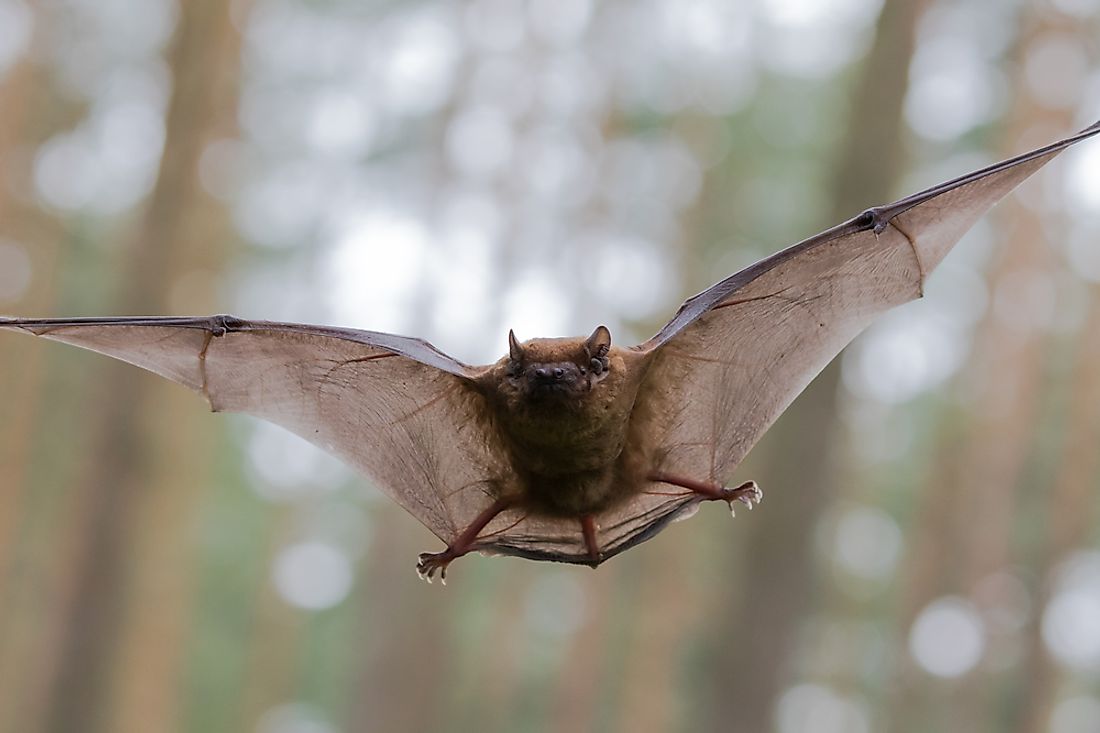Where Do Bats Live?

According to recent estimates, about 1,240 species of bats currently exist in the world. These unique flying mammals come in a wide variety of sizes, the smallest species weighing about 0.07 ounces, while the largest weighs nearly four pounds. It is interesting to note that bats hold the distinction of being the only mammals capable of flying for sustained periods of time. With the exception of extremely cold environments such as the Arctic and Antarctica, varieties of bats can be found throughout the world. The habitats in which these creatures choose to live largely depends on the kinds of food they eat. Research has shown that the most popular regions inhabited by bats are tropical areas, such as Central and South America, which is home to about one-third of all bats on Earth.
Types of Bats
Bats are usually divided into two suborders; microbats use a natural form of biosonar called echolocation in order to hunt their prey while megabats feed on a variety of different types of fruits. The majority of bats are nocturnal and can usually be seen only during the night. Although humans often fear bats, perhaps due to their connection with vampires in popular books or films, the unique creatures play a key role in maintaining the ecosystems in which they inhabit. Not only do they serve to pollinate flowers, but the flying mammals also spread seeds and act as a natural form of pest control by eating large numbers of insects.
Due to their ability to fly, bats are capable of traveling long distances in order to locate adequate amounts of food and suitable shelter. Many types of bats are capable of adapting to a wide variety of different habitats based on numerous factors, such as time of year, weather conditions, and availability of food sources. In the wild bats may construct their roosts in naturally formed structures such as caves, leaves, and trees.
Insect-Eating Bats
In northern locales of the world, such as in the United Kingdom, bats consume diets consisting primarily of insects. In fact, 70% of the world's bats are insect eaters. One such example, the little brown bat, is the most common species of bat in Canada and hunts its tiny prey while in flight. This species of bat typically weighs between 0.25 and 0.49 ounces and has a wingspan ranging from approximately 8.66 to 10.63 inches. The little brown bat is capable of consuming up to a thousand mosquitoes in just one hour.
The majority of insect-eating bats, known as insectivores, subsist on a diet exclusively made up of various insects including beetles, crickets, flies, grasshoppers, termites, wasps, and bees. Some common examples of insect-eating bats include species such as the Mexican free-tailed bat, brown long-eared bat, and various types of horseshoe bats. Due to a variety of natural factors, such as their high metabolic rate and the fact that bats burn large amounts of energy while in flight, these creatures must regularly consume large amounts of food. In fact, those which fed on a diet primarily made up of insects are known to eat amounts equal to about 120% of their body weight.
Fruit-Eating Bats
Bats that primarily consume fruit are known as frugivores. Examples of such bats species include the Jamaican fruit bat and the tube-lipped nectar bat. These bats feed on ripe fruit which they tear off trees using their teeth. Bats which feed on fruit and nectar are naturally equipped with long muzzles and tongues which can be extended directly into flowers. Fruit-eating bats play an important role in the local ecosystems in which they inhabit because they spread fruit and flower seeds, as well as pollinate flowers.
Jamaican fruit bats inhabit parts of Mexico, Central and South America, as well as the Greater and Lesser Antilles including Cuba, Haiti, Puerto Rico, Jamaica, Trinidad and Tobago, and the Dominican Republic. This flat faced bat species eats a diet rich in fruit, such as figs, and the leaves of local plants.
Animal-Eating Bats
Several varieties of bats consume vertebrates as an important part of their diet. Such species include the fringe-lipped bat and greater noctule bat. These bats feed on various small animals including birds, frogs, lizards, and fish.
The unique medium-sized fringe-lipped bat has distinctive bumps on its muzzle and lip areas. It makes its home near ponds and streams in tropical forests and constructs its roosts in natural structures such as caves, hollowed out logs, and trees. The diet of the fringe-lipped bat is made up of lizards, frogs, insects, and even some types of fruit.
Blood-Sucking Bats
A small variety of bats consist on diets rich in animal blood. Such species include the hairy-legged and white-winged vampire bats. These bats usually feed on mammals such as cows and birds.
Hibernation, Migration, and Shelter
Although most species inhabit tropical areas, those living in temperate climates either hibernate during the cold winter months or migrate to warmer locales until the warmer weather arrives once again. Bats are able to occupy a wide variety of diverse habitats such as deserts, mountainous regions, and areas near the ocean.
Bats make their homes in what are called roosts. In temperate climates, such as in the United Kingdom, bats require different roosting environments throughout the year. Roosts can be found in natural structures such as caves or the hollows of trees or human-built structures including buildings and under rooftops. Some bats may even choose to live in roosts located underground. Specific types of roosts are also needed for activities such as hibernation as well as during the birthing process.











